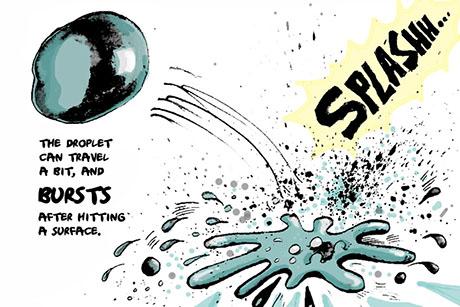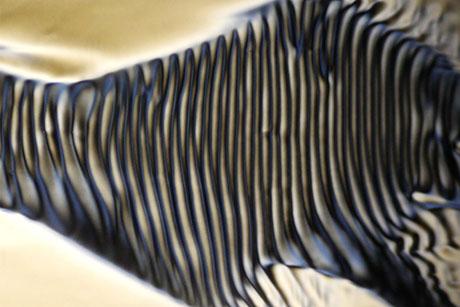GEARing technology for developing markets
Several years ago, as a graduate student at MIT, Amos Winter spent a summer in Tanzania surveying wheelchair technology. What he found was a disconnect between products and the lives of their customers.
“You had normal wheelchairs that worked fine indoors but were tough to take off-road, and you had hand-powered tricycles that worked pretty well on smooth terrain over long distances, but were difficult to manage off-road and way too big to use indoors,” Winter says. “I saw a need for a product that could go fast and efficiently on rough terrain, but was still small enough to use indoors.”
That insight resulted in the Leveraged Freedom Chair (LFC), developed at the Global Engineering and Research (GEAR) Laboratory, which Winter directs. The LFC is an early success story in the emerging field of low-cost, high-performance technology for the rural poor. The novel device, which is powered with a hand lever, incorporates a single-speed, variable mechanical advantage drivetrain. Grasping high on the lever increases torque, while grasping low increases speed. The all-terrain design goes 80 percent faster and enables 50 percent higher peak-wheel torque than a conventional wheelchair. It’s also constructed from standard bicycle parts, making it easier to repair.
GEAR Lab is working on a number of projects aimed at emerging markets, including an irrigation drip system, prosthetic limbs, and a low-cost tractor with an innovative single-cylinder turbocharged engine. “The convergence of the technical and the socioeconomic is the backbone of GEAR Lab,” says Winter, an assistant professor in the Department of Mechanical Engineering at MIT. “One of our core ideas is constraint-driven innovation. The problems we’re trying to solve have, by and large, been solved in wealthier markets. What we’re trying to do is bring a similar level of performance to poorer markets, but at a fraction of the price.”
GEAR Lab projects tend to share two qualities: a compelling need faced by millions of typically poor, rural users, and what Winter calls a "technological keystone" — a challenging technological barrier that requires a groundbreaking solution. “What’s exciting is that we’re running into technical problems that no one has solved,” Winter says. “They involve some fundamental science.”
Along the way, GEAR Lab conducts the research needed to articulate the engineering theory of each gizmo it builds. This includes details on how the technology performs, and how it might scale to different sizes and with different materials — information others can use to adapt the technology to new applications. For example, a high-efficiency drip-irrigation nozzle the lab is building with India’s Jain Irrigation could potentially be adapted for use in a heart valve, Winter says.
Listening to the culture
The biggest challenge in building devices for developing markets lies in understanding a different set of constraints and requirements, Winter says. These often include simplicity, low cost, local repairability, and, when possible, local manufacturing.
“Instead of making this perfect technology and bringing it to the field, we interact with stakeholders early and test prototypes in the field,” Winter says. “Through the LFC project, I learned that we need to blend in socioeconomic factors and find out what people wanted. It’s important to engage the users directly and understand all the factors in their life that will be influenced.”
With GEAR Lab’s “ATKnee” prosthetic knee project in India, for example, Winter discovered that a knee designed for sitting in chairs won’t necessarily work for sitting cross-legged, as is the custom in rural India. “Being able to sit cross-legged contributes a lot to how you interact with your family, how you sit down to dinner,” Winter says. “We were able to catch this design requirement early and redesign the prototype so the leg can twist in a way that lets you sit on the floor.”
In a separate prosthetic foot project, meanwhile, GEAR Lab collaborates with BMVSS — the largest disability organization in the world — to design a lighter, lower-cost version of the the popular Jaipur Foot. In this case, the problem was how to make it easier to squat when wearing the device. Based on input from users, the lab is designing the Jaipur Foot 2.0 to provide ankle flexibility, for easier squatting.
Other adjustments are made after the researchers learn more about the manufacturing, distribution, and repair ecosystem of a given product. “We try to understand the entire chain of stakeholders,” Winter says. “If we capture that early on, it sets us on a better trajectory.”
Winter has launched a startup called Global Research Innovation and Technology (GRIT) to move prototypes developed in GEAR Lab into product form. For example, GRIT has refined the LFC prototype to address the realities of manufacturing, quality control, and packaging. The wheelchair is now being sold in India by GRIT in partnership with Indian manufacturers and nongovernmental organizations (NGOs). “Going from prototype to product is sometimes the biggest barrier,” Winter says.
While GEAR Lab and GRIT often partner with NGOs, including BMVSS, they primarily collaborate with for-profit companies. “They have more motivation for success, and typically, their scale of distribution usually far exceeds that of any NGO,” Winter says. “It’s all about finding the big player that is best positioned to get a product to market.”
Turbocharged tractor aims low
In India, farmers don’t usually invest in a tractor unless they farm at least five acres, Winter says. Yet there are more than 100 million Indian farmers — and 1 billion worldwide — who own less than that. “They’re farming with a bullock, 2,000-year-old technology,” Winter says. “We’re thinking about how we could bring powered farming to these lower-level farmers. It’s an absolutely untapped market.”
Instead of simply designing a cheap, easily repairable tractor, Winter researched the overall needs of small farmers in India. “We found they need more than a tractor,” he says. “What they really need is a mobile power source that can help do a variety of tasks. In addition to plowing and field prep, they may need water pumping and purification, electrical generation, and transportation for the family and for bringing crops to market.”
In order to reduce costs and energy usage, GEAR Lab is looking to build a tractor that will most likely use a single-cylinder diesel engine. The challenge is that it’s tough to provide tractorlike power with only one cylinder. In a tractor design aimed at the U.S. market, one would simply add more cylinders to boost power, but at this level of cost-sensitivity, the rules change.
“In an economy car, the engine cost is a fraction of the overall cost, so going from one to three cylinders is not that big of a deal,” Winter says. “But with a generator, where a major cost is the engine, adding more cylinders can create a pretty significant jump in cost.”
To gain more power from a single cylinder, GEAR Lab is looking at new ways to turbocharge it to force more fresh air into the engine in order to burn more fuel. “Historically single or two-cylinder engines haven’t been turbocharged because of the mismatch of how the turbo is powered with the exhaust and when fresh air is drawn into the engine,” Winter says. “We’ve figured out a way around that mismatch.”
Winter tries to keep his projects focused, and often depends on the expertise of partner companies to fill in the blanks. “The key is whether my partner organization has the skillset to create all of those other elements we can’t build, so we can focus on the technological keystone,” Winter says. With the irrigation project, for example, GEAR Lab is building a drip emitter that can run on lower pressure, and therefore lower power. It’s up to Jain Irrigation to package the driplines, pump, panel, and other components.
In the future, Winter says he may move up to “larger, system-scale challenges.” For example, he’s been puzzling over how to design and package multifaceted microinfrastructure for undeveloped villages that would bring together electricity generation, water delivery, sanitation, and more for a single village.
So far, GEAR Lab has started with a solar-powered water purification system in collaboration with Jain Irrigation. It’s a modest first step, but it could have a big impact on the quality of life of thousands, if not millions, of people.


